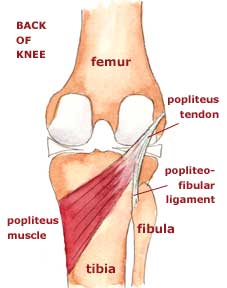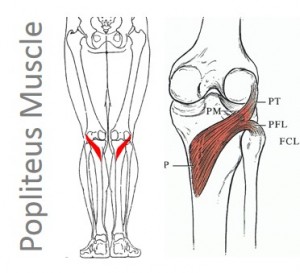The popliteus is a small muscle found behind the knee. Its origin is on the outside of the base of the femur bone, the lateral condyle.
It inserts on the outside of the back of the tibia, the larger of the two shin bones. It is a triangular-shaped muscle and though small, it has a great influence on the movements of the knee.
Due to its size, it is often overlooked in favor of the calves and hamstrings when considering the back of the leg.
But size doesn’t always denote power when it comes to muscles.
The triangular shape of the popliteus muscle means that a large portion of its mass attaches along the tibia.
I’ve written before that triangular muscles are usually movers and muscles with a broader base of attachment often pack a greater punch. Popliteus fits the bill in both of these cases.
When you stand up with your legs straight your popliteus muscle is not doing much. But begin to take a step, or employ any related movement of the knee, and the popliteus frees up the joint and flexes the knee.
It also allows for rotation in the large hinge-type joint.
The different joints of the body have different rotational abilities. Your ankle joint is a very strict hinge with no rotation.
Though the knee is also a hinge joint there is some play allowed and any rotational movement is initiated by the popliteus muscle.
If you are standing and the knee flexes, which means the foot moves up behind you towards the pelvis, the popliteus instigates this action creating a medial (inner) rotation of the tibia bone. as well. If the foot is planted the opposite action will occur and the femur will laterally rotate above the knee.
To recap the three basic functions of the popliteus muscle:
- It helps to flex the knee
- It laterally rotates the upper leg on the lower leg when the foot is planted.
- It medially rotates the lower leg below the upper leg when the foot is off the floor.
Poor movement patterns and posture often weigh heavily on the popliteus muscle leaving it prone too weakness and injury.
Any inury to the knee will likely involve the popliteus muscle.
I think that everyone depends too much on the outer body.
Weight tends to fall towards the outer feet and we tend to be tighter and stronger in the outer leg as opposed to the inner.
If the hamstrings towards the outer thigh are stronger than the inner hamstrings, the popliteus muscle will be weaker.
Excessive pronation or collapse of the inner foot when walking or running will stress the popliteus in the opposite direction.
Developing balance in both the skeletal and muscular systems is essential for all of our muscles and joints but particularly important when it comes to our knees.
***


